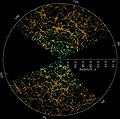Copernican principle
The Copernican Principle proposes that the universe looks the same, whichever direction the observer looks no matter where that observer is placed. As such it is really more a statement of assumption, or origins science rather than observational or operational science based on strictly scientific data. It is often cited as being in opposition to the Anthropic principle. It is more or less synonymous with the Cosmological Principle which suggests that the universe is homogenous and isotropic on large scales. In other words matter is spread out essentially even, all across space in every direction with no boundary to space. It is often assumed by secular naturalists that the Copernican Principle is proven; however, nothing could be further from the truth.
Most seem unaware that the Copernican or Cosmological Principle is rather for the global structure of the universe breaking down more and more as it focuses on more and more local phenomena. So for instance a persons house and the local restaurant are obviously different. But as you pull out and bring into view the grander, global universe incorporating and comparing massive clusters of millions of galaxies in one portion of the universe to the other, it will look relatively similar. It is considered a property of the global universe.[1]
Evidence Against
Axis of Evil
The Axis of Evil is a name given to a discovery of polarization of rotations of galaxies. Galaxies can only rotate two ways: clockwise or counterclockwise. In a universe governed by the Copernican Principle/Cosmological Principle the distribution of spins would be 50/50 clockwise and counterclockwise but observation shows they are polarized more towards 51-49, more with clockwise spins than counterclockwise. If the universe were isotropic (meaning it is governed by the Copernican Principle) then the odds of this occurring are less than 1 in 1-billion. [2] [3] [4]
Large Structures
Sloan Digital Sky Survey
The Sloan Digital Sky Survey is a large scale mapping of galaxy locations. It has discovered the Milky Way is located near the center of numerous concentric rings of galaxies stretching billions of lightyears around us. The Copernican Principle cannot conform to this known level of structure.
Some critics claim this is caused by an observer effect but this is not likely because if it were caused by an observer effect we would expect the center to align with the observer but it does not. The Milky Way is near the center but not at the center.
Some critics also argue that the Sloan Digital Sky Survey is only a few billion light years across and therefore does not disprove uniformity at larger scales beyond its view. This claim is appealing to blind faith. It is not evidence based. The evidence we do have for large scale mapping of galaxy locations shows concentric rings with the Milky Way near the center.
Giant Arc
In 2021 a large-scale structure was discovered called the Giant Arc that stretches 1/15th the radius of observable universe or 20 times the width of the full-moon in the night sky. Three statistical tests have been performed to determine if it was a random fluke with 99.99997% certainty it is not. [5]
| “ | "... the odds of it being a statistical fluke are less than 0.00003 percent." [5] | ” |
South Pole Wall
In 2020 a large-scale structure was discovered called the South Pole Wall that stretches more than 1% the width of the known universe. It rivals the 6th largest cosmic structure ever found: the Sloan Great Wall. [6]
Sloan Great Wall
Giant Gamma-Ray Burst Ring
Huge Large Quasar Group
References
- ↑ An Introduction to Modern Cosmology by Andrew Liddle. Page 19.
- ↑ Starr, M. (2020, June 2). Patterns formed by spiral galaxies suggest the universe’s structure isn’t totally random. ScienceAlert. https://www.sciencealert.com/the-spin-directions-of-spiral-galaxies-suggest-the-axis-of-evil-is-real
- ↑ https://arxiv.org/abs/2004.02963
- ↑ Shamir, L., Patterns of galaxy spin directions in SDSS and Pan-STARRS show parity violation and multipoles, Astrophysics and Space Science, 365, 136, 2020.
- ↑ 5.0 5.1 https://www.sciencenews.org/article/galaxy-giant-arc-3-billion-light-years-long-cosmology-space
- ↑ Mann, Adam. “Astronomers Discover South Pole Wall, a Gigantic Structure Stretching 1.4 Billion Light-years Across.” livescience.com, 10 July 2020, www.livescience.com/south-pole-wall-discovered-in-space.html.



